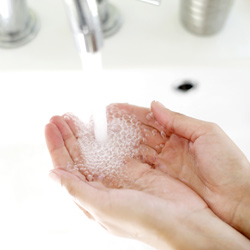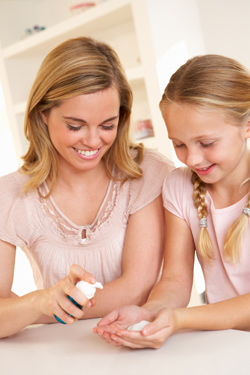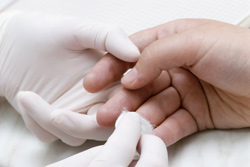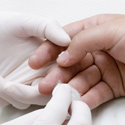Parents, teachers and daycare providers, in following the guidelines for keeping the flu at bay, may be unwittingly causing a bigger problem. I began to see them a few years ago. Children with red, swollen hands, littered with bleeding cracks and scales.
“We are supposed to sing Twinkle-Twinkle Little Star and not stop washing our hands until the song is over,” a boy told me. “Do you think it is contagious? We’ve been having him wash with antibacterial soap. Several other kids in his class have the same thing,” said his mother.

His symptoms were not contagious, or even infectious for that matter. In fact, the fear of infection is what led to this. He was simply over-washing his hands to the point of inducing hand eczema.
With the rise of antibiotic-resistant strains of bacteria showing up in schools and locker rooms, institutions have responded by implementing aggressive hand washing protocols with harsh soaps and alcohol-based hand sanitizers. While this should generally be applauded, some of these children have over-washed their hands to the point that their tender skin will harbor more bacteria and viral particles. These infection-prone little hands often end up chapped, painful, and even bloody.
School budgets usually can only provide for soaps so harsh that they could double as paint strippers. The vat of pink or green soap in most school restrooms does a great job at killing bacteria; but it also robs the skin of its protective layers that keep things out and the moisture in.

Adding alcohol-based hand sanitizers compounds the issue. The aggressiveness of the wash is often totally out of proportion to the soiling. Do we really need elementary schoolchildren furiously scrubbing their already chaffed and bleeding hands for two whole minutes after going “number one”?
Prior to the germ theory of disease, human illness was either attributed to a variety of gods and spirits, or just being unlucky. The first doctor to actually study the effects of hand washing, Dr. Ignaz Philipp Semmelweiss (1818-1865), was rewarded by having his medical licensed stripped and was laughed out of the profession.
As he watched the gentlemen doctors go from patient to patient, and often from autopsy to patient, he had a revolutionary idea: the doctors were infecting their patients. By placing chlorinated lime water between patients, he forced his student doctors to wash after each delivery. Puerperal fevers rates plummeted. Rather than celebrating this pioneering work, the medical community ostracized poor Ignaz.

No one will argue that healthcare workers need to remain vigilant. The rate of hospital-acquired infections is stunning with no real positive outlook on the horizon. But like with the children, at some point I think the pendulum swings too far. Washing my hands around 20 times a day in the winter months seems to be my personal threshold to develop painful cracks in my hands. Even my best efforts as a dermatologist and the access I enjoy to gentle cleansers are sometimes not enough to keep my skin from suffering. Thankfully hand sanitizers can be an appropriate substitute to washing and are readily available in most health care facilities.
Keep a watchful eye on your children’s hands, talk to them and their teachers about becoming over-zealous, and do a little research on yourself to find the best balance for your family.
Dr. Derrick Adams is a board certified dermatologist and the medical director of Vita Dermatology and Laser Institute, a division of Lassen Medical Group in Red Bluff. His office can be reached at 528-VITA.

